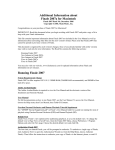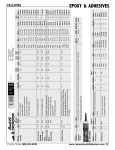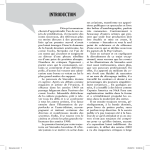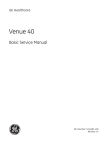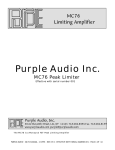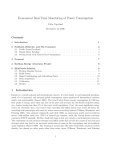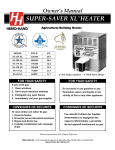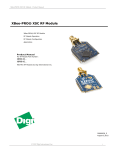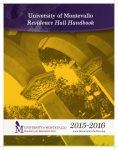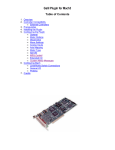Download July - The Alabama Historical Radio Society
Transcript
July 2011 A NOTE FROM PRESIDENT DEE Wow!! What a month. The trip to Alpharetta, Georgia, was fun, except for getting up at 3 in the morning. But, I’ll let Dave Cisco tell you all the details. The Legends of Broadcaster Reunion went off without a hitch. We got to meet a lot of really nice people. (See Ed Boutwell’s article in this newsletter). The new shop is coming along slowly. We need more people to come to the work parties. Please let me know if you can come in and help clean, sort, move, or just give out moral support. A lot of work is being done by just a few people. Why don’t we make that a lot of people are helping us put our shop on the map? Thanks to Joel Tillman for keeping an expert eye on bargains in quality tools. Joel has recently ordered Xcelite hand tools, and other quality brands of test equipment from reliable eBay sellers and other sources. Thanks also go out to Joel for the eye candy TO display that was so prominent in the WVTM coverage. Thanks also to Randal Murphree for locating several Simpson 260 VOMs. These units are from the estate of a man who repaired Simpson meters for years in the Birmingham area. Dee Haynes 243-4630 or [email protected] LISTEN TO THE RADIO!! About OTR, I finally finished up my collection of Lum and Abner episodes and have moved on to Vic and Sade. Like Lum and Abner, Vic and Sade was a daytime 15minute comedy show that aired during the soap opera time slot. Written by Paul Rhymer, the show became one of the most popular radio shows and remained in the top five during its run on radio. Starting in 1932, the show continued until the mid 1940s. Time Magazine reported that in 1943, the show reached over 7 million people. These shows are available in our own DVD collection or on the internet free of charge. Try listening to a few of these old shows. It will probably lower you blood pressure by a few points. OK, I’ll shut up and let someone else have the mike. Dee Haynes 243-4630 or [email protected] The Gathering By Ed Boutwell Wow! There they were--some my age, but most old enough to treat me like a little brother. When I moved back to Birmingham from Huntsville in 1956, I went to work for WAPI AM and FM. The Format was "Good Music," and the announcers had these rich, deep, wonderful voices with perfect diction. Since I was barely 17 years old, I have always considered that is the way an announcer should sound. Last week, our antique radio club invited around twenty of these old codgers ('er, announcers) to visit our new clubhouse in downtown Birmingham. We lovingly showed off our collection of antique radios and all of us then went to lunch across the street at the Power Company. By the way, I should mention that the home of WSY radio (Alabama Power) is very helpful to our club. In fact, our museum display of marvelous old radios is in the Atrium at the home office of said benefactor. Now, back to our visitors from the past…as we met in Homewood to come downtown, memories of those five years at WAPI came rushing back into my old mind. These guys may not know it, but they are big brothers to me. Everyone (especially me) had a super time and said we should do this on a regular basis. Some of them want to join our club ! EDITOR’S NOTE If you missed the WVTM 13 video last Tuesday night about the reunion, here is a link: http://www2.alabamas13.com/news/2011/jul/07/spirit-of-alabama-the-good-oledays-in-14257-vi-85231/ Dee’s Don’t Do It Or You’ll Be Sorry!!! Have you ever slowly tightened the last bolt on the engine block without a torque wrench? And you thought, well, I’ll just turn it another 5 degrees and then… SNAP! Thank goodness I never had that experience, but I’ve had a few that are similar. Recently, I came across an old RF signal generator that I thought was unusual and decided to restore it. I completely disassembled it, which included removing the dial that looked like it was stained with years of cigarette smoke. Without consulting the “how to” book, I first tried a damp cloth. That didn’t work. Next I tried some CLR. That didn’t work. So what should I try next? Looking through my wife’s cleaning chemicals, there sat a bottle of Clorox. I gently applied the Clorox and, like magic, the yellow turned to white. That was simple, I thought and then dipped it in clean water to finish the process. I’m sure you know what happened next. The beautiful white paint vanished in a swirl of water. Thank goodness the black and red lines and lettering remained…partially anyway. One of the first rules of restoration is take a picture of what it looked like before you screwed it up! I didn’t do that, but this is what it looked like after I washed most of the white paint from the dial. The only thing to do now is spend hours and hours in front of a computer screen with Adobe Photoshop and turn this thing back into what it looked like originally. Here is what the dial looks like after a few hours at the computer. I’m still not through with it, but it is close to what it should look like. When I finish the restoration, I hope to add this piece of test equipment to our shop. I will keep you posted with updates on how this little project goes. Well, here’s the dial installed back in the unit after I printed it on photo paper and sprayed it with polyurethane I’m not sure where the pale sky blue background came from, but I’m not going to change it. I spent a lot of time messing with the colors trying to get the red as close to original as possible. The cabinet probably needs a new paint job, but I am going to pass on that. Now, if I could only find the alignment procedure for this thing, I could return it to its former glory. I searched the internet and our own library for any information on this test set, but could find nothing. I would appreciate it if someone could furnish me with a schematic or a copy of a user’s manual. I would love to calibrate it. It is a model 640 Test Oscillator manufactured by The Jackson Electrical Instrument Company of Dayton Ohio. Thanks, Dee Haynes 243-4630 or [email protected] NOTE FROM DAVE CISCO The article below is the last of a four-part article for the newsletter, which was written by well-known author and photographer, Joe Veras. Joe has written several books, written for CQ and QST Magazines, and is on the ARRL publishing staff. He recently produced a calendar of old radios for ARRL and included a Tuska radio that AHRS owns. I am proud to have him contribute to our newsletter. JAMES MILLEN – Part Four By Joe Veras, K9OCO Following his exit from National, James Millen established the James Millen Manufacturing Company located at 6 Pleasant Street in Malden, Massachusetts. A fullpage announcement in June, 1939 QST stated that it would be devoted to the design and production of new radio communication products including components, receivers, and transmitters. A catalog insert with a comprehensive product line also appeared in the same issue of the magazine. Although the move came as a surprise to some, it had obviously been on Millen’s mind for a long time. With all the reins of a company in his own hands, Millen soon learned which way and how hard to pull to keep things moving in the right direction. Much of the company’s business consisted of subcontract work done for larger companies such as General Electric or RCA. James Millen Manufacturing’s first ham product was the Hetrofil, a wien bridge audio filter designed to be plugged into the headphone output of a receiver. Its phasing action could notch out an interfering heterodyne on a phone or CW signal. The design was originally presented in a September, 1939 QST article by Raymond Woodward, W1EAO. He licensed it to Millen for manufacture, and it ran in the company’s ad a month later. This practice became commonplace in the years to follow, with many products based on magazine or handbook circuits, but was something of a two-way street first paved by Millen at National. In his monthly QST ads, as well as articles penned for that magazine and others, he often shared circuits and ideas with readers. James Millen Manufacturing, as did National, made components as well as complete sets. In an era when home-brewing was prevalent, advertising parts made good sense. If you remember the Millen ads, many months were devoted to touting a single component, standing there in its little circle of light. If you bought Millen equipment and received what was essentially a handbook circuit, you weren’t exactly getting shortchanged. It was well-made gear using quality components. Given his dedication to quality first, perhaps this arrangement kept it affordable. The love of high-performance receivers was near the core of Jim Millen’s soul. When he started his own company, it was on his mind to design such a receiver, something to follow the HRO. These plans, along with those of so many other companies, were shelved during the war years, but in 1947 his ultimate receiver emerged. The DFP-501 had direct frequency readout, motor-driven band switching of ten ham and general coverage bands, motor-assisted tuning, and a crystal filter in the 455 kHz 2nd I.F. The 19-tube set used a movable coil catacomb much like the NC-100/101 designs. Bands changed at the push of a button. Every feature of the receiver was the ultimate for its time. This, combined with its superb build quality, made production costly. It would have to be priced far beyond what the amateur market would pay. A couple of prototypes samples were all that were ever seen of the DFP-501. Millen went back to the drawing board and a simpler, less feature-laden Model DFP-201 was designed. The 201 was also double-conversion and had a sliding coil catacomb, but lacked the power tuning and push-button band-changing of the 501. Several DFP201 prototypes were completed and examples of both it and the 501 were taken to a trade show in Chicago during May, 1947. Meanwhile, it was discovered that production cost alone on the 201 prototype was more than two thousand dollars (nearly $20,000 in today’s money), so it was added to the scrap heap along with the 501. James Millen never did make a receiver branded with his own name. Most Millen ham equipment qualifies as vintage gear today. Under Jim Millen’s guidance, the company lasted until 1977, though the name has been revived a couple of times since by successor companies. He died a decade later in June of 1987 at his residence in North Reading, Massachusetts. No obituary ran in the Malden newspaper, where James Millen Manufacturing had been located for nearly 40 years, but a street in North Reading now bears his name. Another curiosity: it is reported that much ARRL editorial work, on both QST and the handbook took place at Millen’s farm in the 1930s…and that through Jim’s influence National Company ad money heavily subsidized League publications. His obit in QST 50 years later rated but two brief paragraphs, one only a short sentence in length. OUR TRIP TO SARS EVENT IN ALPHARETTA, GEORGIA By Dave Cisco The Southeastern Antique Radio Society (SARS) held its summer swap meet and auction Saturday, June 18, 2011, in the parking lot of the Fairfield Inn in Alpharetta, GA. Eight members of AHRS attended. Besides having to leave the shop at 4am it was a great day. Our member Tom Hayes had already set up and was selling when we arrived. Fortunately the weather for this event was great. The official time was from 8am EDT until noon. There were about 25 different vendors, mostly with an open trunk, but some had tables or blankets on the ground. The event was capped off with an auction for the club’s benefit. Several items went very cheap. Our members bought several items: Dwight Crider came home with a console radio, a microscope and some small items. Mack White had a very old tube tester and some parts. I bought a 6 transistor GE radio like the one my dad had given me for high school graduation. We all had a good time and came back planning our own show at some future date. You can view the event on YouTube by Googling- SARS and location and date. MEETING TIMES We meet nearly every Saturday of the month at 09:00 AM in the one-story building at the corner of 8th Avenue North and 18th Street (1801 8th Avenue North, Birmingham, AL 35203). Use the rear (Southeast) entrance. Come to the Monday Night Meetings, TOO, on the 4th Monday of the month at 7 PM! NOTE ABOUT ROBERT’S CLASSES Due to the holiday schedule, Robert’s classes will be held July 16. You’re going to love the shop! FREE ELECTRONICS CLASSES The first Saturday of the month, there are electronics classes free to members. Topics include test equipment, Resistors and Capacitance testing, Inductors and coil winding, to name only a few subjects! We hope to see you there! DUES ARE NOW DUE Membership dues are $25 a year, payable beginning in January. If you have questions about your dues, you can contact Tom at 205-967-7000. Dues can be mailed to AHRS @ P.O. Box 131418, Birmingham AL 35213. WHO TO CONTACT President – Dee Haynes 243-4630 [email protected] Member and Instructor – Robert Frye 205.631.6680 [email protected] Web site – Bob Lovell [email protected] Web Address: http://alhrs.org E-mail Address: [email protected] Newsletter – Patsy Desaulniers [email protected]













